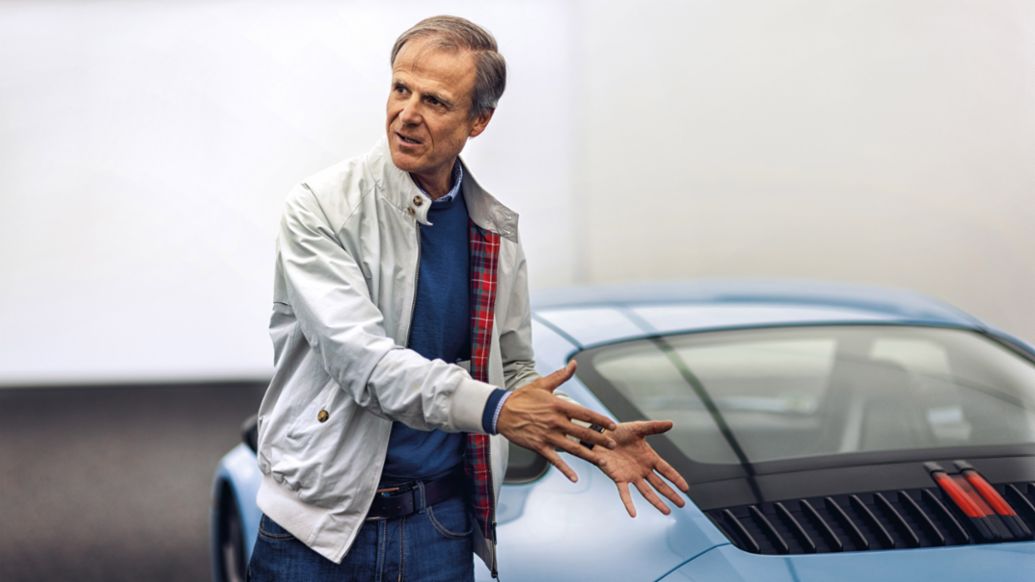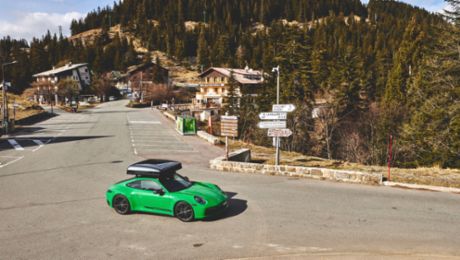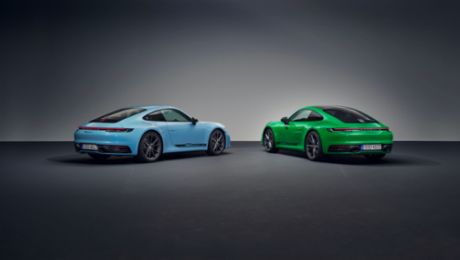Mr. Mauer, when you compare the current 911 to the first generation, what sort of emotions do you feel?
Michael Mauer: I recognize the wonderful consistency. The 911 has maintained its identity and has always been ahead of its time. It accommodates evolving aesthetics and yet remains true to its line. Its evolution from then to the present day reveals why designers are the brand guardians.
Could you describe the first 911 for us?
Mauer: It’s a futuristic interpretation of the sports car – a design that you really can’t improve on. Whenever we try out a different silhouette, we end up back at the original roofline. It’s just so memorable. And yet the car never feels bulky or aggressive. And that’s despite the fact it has always been one of the fastest. That’s what I find so fascinating.
.jpg/jcr:content/Mutprobe%20(4).jpg)
How would you characterize the current, eighth generation?
Mauer: The current model is best described in comparison with its direct predecessor. As an athlete, it’s now more muscular, but it’s still understated compared to its extroverted competitors in the same performance class. Self-confident, but without the arrogance.
Can you tell us in one sentence what distinguishes the design of the 911?
Mauer: I’m always looking for expressions to describe a Porsche once and for all and have come up with a wonderful pair of words: designed precision.
“In a world full of explanations, design should be self‑explanatory.” Michael Mauer
If the 911 were a person, what would its personality be like?
Mauer: Someone who avoids the limelight. But someone who everyone knows can do a lot extremely well. In the world of sports, it would be a triathlete: lean, fit, and exceptional in multiple disciplines. It would be someone I’d go to for advice because they support me and help me advance. Ferdinand Alexander Porsche, who sketched the first 911, was a free spirit. He’s the one who gave the car its self-confidence, establishing its personality in the process.
Are there days in your professional life when you don’t think about the 911?
Mauer: Yes, there are. But it doesn’t bother me. In fact, as my experience grows, I can feel that the solution is already there. I just don’t see it yet.
Your greatest challenge as a designer?
Mauer: For us, it’s always about creating irresistible design. In the world of design, that’s the be-all and end-all. You could almost say it’s art. But for me, that alone wouldn’t be enough for a product. For me, it’s about creating irresistible design that strengthens the brand and positions it well. Design that visualizes all of its values. Only then can design reign supreme.
Porsche is a strong brand, and the 911 a strong model. Are those two things in competition with each other?
Mauer: It’s helpful to have an icon in the product range. A model that not only shapes the industry over a longer period of time, but is also unique and boosts recognition. An icon provides better inspiration for the brand’s design philosophy. For me, the 911 is the North Star for the entire brand universe.

You like to talk about your “creative muscle,” but have also established clear criteria for the design process at Porsche. Those two things sound mutually exclusive. How do they fit together?
Mauer: It’s always difficult for designers to rationalize what they do. Much of it is gut feeling, pure intuition. But that’s exactly what forms the basis for billions in investment. Engine developers have test bench numbers that can be measured. That’s why I went looking for something to structure our intuition and make it measurable in some way.
The result is a dedicated Porsche design style. What does it look like?
Mauer: Of the twelve traditional archetypes of psychology, we selected three that apply to us: the hero, the creator, and the rebel. We decided to give these archetypes faces: James Dean, Ferdinand Porsche, and Steve McQueen. This personification leads to mind movies. We can imagine the direction design needs to move in to correspond with these protagonists. What follows is the most difficult part of the process. We apply key terms – “tension,” “purpose,” and “focus” – to the three faces, which help us to translate ideas into concrete design. Focus refers to the hero, purpose to the creator, and tension to the rebel.
Does this philosophy have an impact on the design?
Mauer: The three terms reflect our values and therefore also serve as inspiration for our in-house processes. As a result, everyone suddenly has images in their mind that describe one direction. For me, design is so much more than just designing shapes. It’s also about designing a brand. And that’s where this consistency comes in. The result is ultimately identity.
.jpg/jcr:content/Mutprobe%20(1).jpg)
One of your favorite design terms is “current flow.” What exactly does it mean to you?
Mauer: Anything that generates power – or excitement. The interior, for example, consists of tactile, digital, analog elements, which form thrilling contrasts. The surfaces on the outside create excitement. I’d even refer to them as highly electric surfaces! You simply have to run your fingers along the 911 to feel it.
How do you interpret timelessness?
Mauer: The term provides me with guidance for what the Porsche brand has represented for many years – and what we aim to communicate in the future. Something needs to be aesthetically pleasing and emotionally charged to be irresistible. In a world full of explanations, design should be self-explanatory.
Was it difficult for you to design your first 911?
Mauer: I was glad that my first project was not the new generation of the 911. I had enough time to develop an understanding of what sets a Porsche apart. You need a certain degree of standing. When it comes to the 911, it’s not the usual ten people at the company who have a say. It’s more like a hundred. It’s not just about whether the car is attractive, but also whether it’s still a 911. After all, the 911 bears a great deal of responsibility. It’s the head of the Porsche family.
.jpg/jcr:content/Mutprobe%20(3).jpg)
How do you deal with this level of responsibility?
Mauer: To begin with, we proceed as if the new 911 was like any other project. As a designer, you should never feel restricted from the very start. We require targeted provocations to make progress. And then when it comes to the actual design, you ask yourself, how far should I go? Or, don’t we need to go even further?
How far ahead do you plan for the 911?
Mauer: The “911 – Year 2050” project is underway at our future laboratory. We look very far into the future and consciously skip three vehicle generations. There’s no way for us to know now what kind of drive technology the 911 will have then. But it’s more than a thought experiment. It provides tangible inspiration for current processes. We think well into the future and then, like researchers, work backwards – for example, to the year 2030. The result is different images, perspectives, social frameworks, as if we were to work our way forward in a purely evolutionary way.
What will the next Porsche 911 look like?
Mauer: Like a 911. Even if a few elements of the design style have changed, you’ll be able to see that it’s a 911 at first glance. But also a new Porsche 911.
Info
Exclusively pre-published in the Porsche Newsroom: the interview with Michael Mauer, along with plenty more must-read content, will be published in issue 408 of the Christophorus Magazine, available to read online from 15 September at christophorus.porsche.com.
Author: Elmar Brümmer
Photos: Heiko Simayer
Copyright: All images, videos and audio files published in this article are subject to copyright. Reproduction in whole or in part is not permitted without the written consent of Dr. Ing. h.c. F. Porsche AG. Please contact newsroom@porsche.com for further information.
.jpg/jcr:content/Mutprobe%20(5).jpg)


